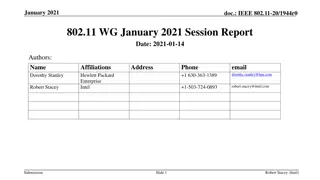
Understanding Frequency Histograms for Data Analysis
Discover the power of frequency histograms for organizing and visualizing data sets. Learn how to create frequency distributions, interpret histograms, and differentiate between frequency and relative frequency histograms. Explore the significance of cumulative frequency histograms in analyzing data patterns and outliers.
Download Presentation

Please find below an Image/Link to download the presentation.
The content on the website is provided AS IS for your information and personal use only. It may not be sold, licensed, or shared on other websites without obtaining consent from the author. If you encounter any issues during the download, it is possible that the publisher has removed the file from their server.
You are allowed to download the files provided on this website for personal or commercial use, subject to the condition that they are used lawfully. All files are the property of their respective owners.
The content on the website is provided AS IS for your information and personal use only. It may not be sold, licensed, or shared on other websites without obtaining consent from the author.
E N D
Presentation Transcript
is a type of bar graph that shows the frequency, or number of times, an outcome occurs in a data set. It has a title, an x-axis, a y-axis, and vertical bars to visually represent the data. Frequency histograms help organize data and make it easier to understand.
To make a histogram, follow these steps: On the vertical axis, place frequencies. Label this axis "Frequency". On the horizontal axis, place the lower value of each interval.( or the interval or the mid class value) Draw a bar extending from the lower value of each interval to the lower value of the next interval.
A frequency distribution shows how often each different value in a set of data occurs. A histogram is the most commonly used graph to show frequency distributions. It looks very much like a bar chart, but there are important differences between them.
Use histograms when you have continuous measurements and want to understand the distribution of values and look for outliers. These graphs take your continuous measurements and place them into ranges of values known as bins. A frequency distribution table lists the data values, as well as the number of times each value appears in the data set. A histogram is a display that indicates the frequency of specified ranges of continuous data values on a graph in the form of immediately adjacent bars.
A Relative frequency histogram The only difference between a frequency histogram and a relative frequency histogram is that the vertical axis uses relative or proportional frequency instead of simple frequency.
A Cumulative Frequency Histogram A Histogram and Cumulative Frequency Plot. Histograms and the cumulative frequency plots are both used to visually study the distribution of a dataset. A histogram shows the number of data points which lie within pre-defined intervals (bins). ... The width of the bins is only necessary parameter for a histogram.
From Example At Lecture 3 Cumulative Frequency 3 6 8 11 13 Mid Class 52.5 58.5 64.5 70.5 76.5
Cumulative Frequency 14 12 10 8 6 4 2 0 1 2 3 4 5 Cumulative Frequency



















